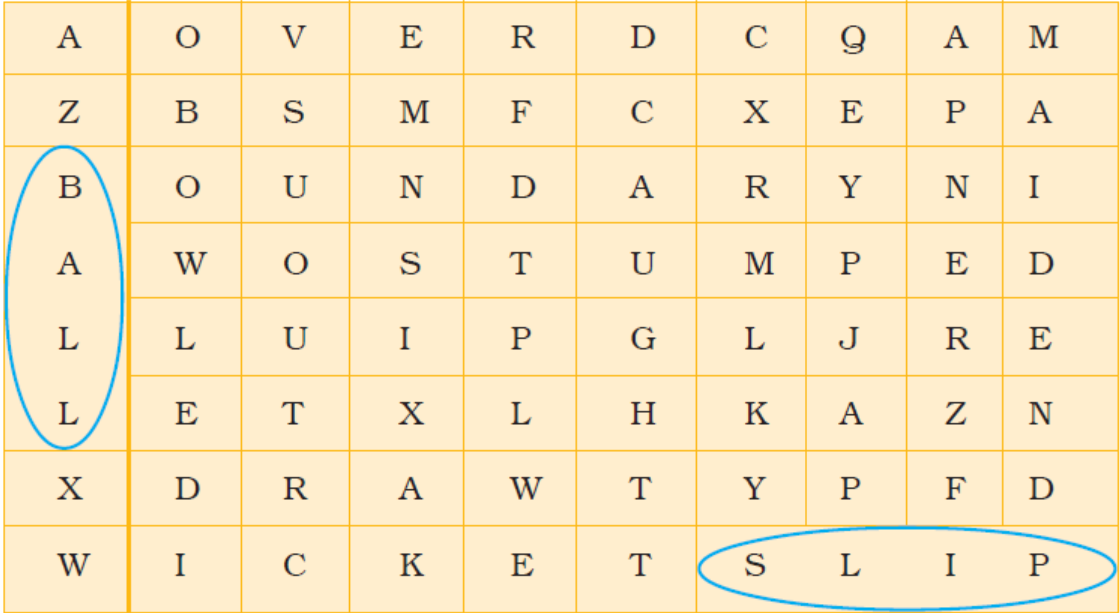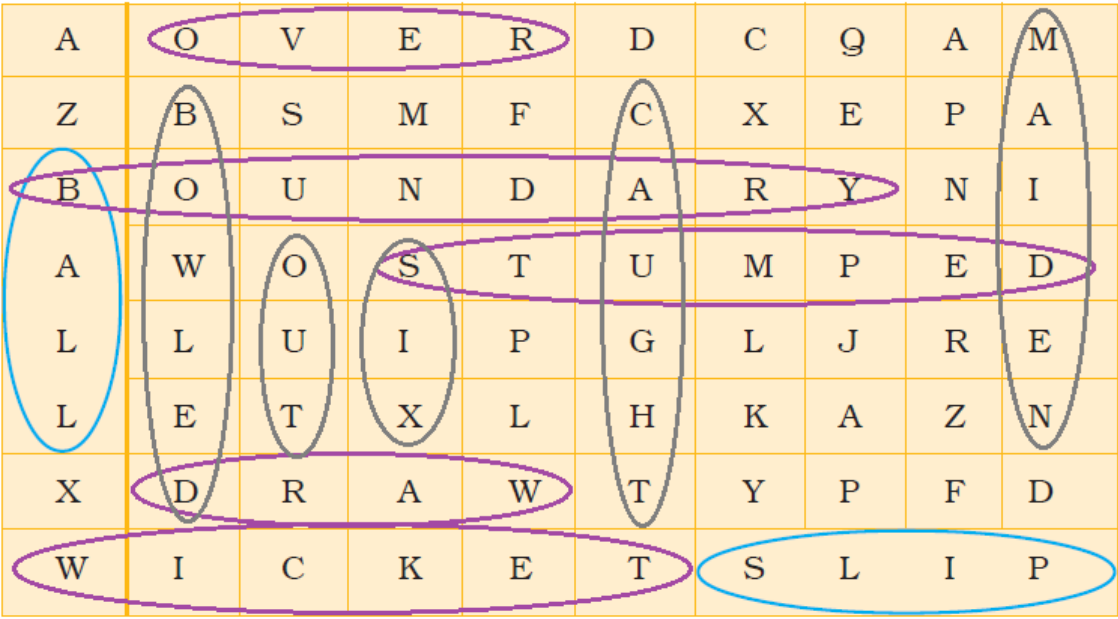
NCERT Solutions for Class 7 English Honeycomb Chapter 10
NCERT Solutions for Class 7 English Honeycomb Chapter 10: Below, we have provided the NCERT Solutions for Class 7 English Honeycomb Chapter 10, "The Story of Cricket," covering all the questions from the textbook Honeycomb. Our subject experts have carefully prepared these solutions, adhering to the standards set by the CBSE board. Cricket holds a significant place in India's sports culture. Who brought it to our shores? When did the love for cricket begin to grow? Which Indian group embraced cricket? You can find the answers to these questions in the chapter titled "The Story of Cricket." Additionally, the chapter discusses the unique aspects of cricket compared to other sports and its evolutionary journey over time.CBSE Board Exam Centre List 2024
NCERT Solutions for Class 7 English Honeycomb Chapter 10 The Story of Cricket
NCERT Solutions for Class 7 English Honeycomb Chapter 10 are discussed below for CBSE class 7 students. Find all the solutions here:Comprehension Check
Question 1. Cricket is originally a/an(i) Indian game.
(ii) British game.
(iii) international game.
Mark the right answer.
Answer: (ii) British game. Question 2 . “There is a historical reason behind both these oddities.” In the preceding two paragraphs, find two words/phrases that mean the same as ‘oddities’. Answer: The two words/phrases that mean the same as ‘oddities’ are:- peculiarities
- curious characteristic

Comprehension Check
Question 1 . Write True or False against each of the following sentences.(i) India joined the world of Test cricket before Independence.
(ii) The colonisers did nothing to encourage the Parsis in playing cricket.
(iii) Palwankar Baloo was India’s first Test captain.
(iv) Australia played its first Test against England as a sovereign nation.
Answer: (i) True (ii) True (iii) False (iv) FalseComprehension Check
Question 1. A ‘professional’ cricket player is one who makes a living by playing cricket. Find the opposite of ‘professional’ in the last paragraph. Answer: The opposite of ‘professional’ given in the last paragraph is ‘amateur’. Question 2 . In “the triumph of the one-day game”, ‘triumph’ means the one-day game’s(i) superiority to Test cricket.
(ii) inferiority to Test cricket.
(iii) achievement and success over Test cricket.
(iv) popularity among viewers.
Mark the right answer.
Answer: (iv) popularity among viewers. Question 3 . “…the men for whom the world's a stage”.(i) It refers to the famous cricket fields in the world.
(ii) It means that there are many cricket playing countries in the world.
(iii) It implies that cricketers are like actors and every cricket ground is like a stage on which the drama of cricket is enacted the world over.
Mark the right answer.
Answer: (iii) It implies that cricketers are like actors and every cricket ground is like a stage on which the drama of cricket is enacted the world over.Working with the text
Answer the following questions. Question 1 . Name some stick-and-ball games that you have witnessed or heard of. Answer: Apart from Cricket and Hockey, some of the stick-and-ball games that I have witnessed or heard of are:- Golf
- Squash
- Polo
| CBSE Syllabus Class 7 | |
| CBSE Class 7 English Syllabus | CBSE Class 7 Math Syllabus |
| CBSE Class 7 Social Science Syllabus | CBSE Class 7 Science Syllabus |
Working with language
Question 1. Wordsearch- Twelve words associated with cricket are hidden in this grid.
- Six can be found horizontally and the remaining six vertically.
- Two words have been found for you.
Clues to the hidden words are given below.
Horizontal: six deliveries, four runs, attacked while out of arena, no result, stumps, fielder to the off side of the wicketkeeper
Vertical: stumps flying, back to the pavilion, a lofty one, mid-air mishap, not even one out of six, goes with bat
 Answer:
Answer:
 Question 2:
Add -ly to the italicised word in each sentence. Rewrite the sentence using the new word.
Question 2:
Add -ly to the italicised word in each sentence. Rewrite the sentence using the new word.
See the examples first.
- He runs between wickets as if his legs were stiff.
He runs between wickets stiffly.
- Why did the batsman swing the bat in such a violent manner?
Why did the batsman swing the bat so violently?
(i) It is obvious that the work has not been done in a proper way.
(ii) He made the statement in a firm manner.
(iii) The job can be completed within a week in an easy way.
(iv) You did not play in a serious manner, or else you would have won the match.
(v) She recited the poem in a cheerful manner.
Answer: (i) It is obvious that the work has not been done properly. (ii) He made the statement firmly. (iii) The job can be completed within a week easily. (iv) You did not play seriously, or else you would have won the match. (v) She recited the poem cheerfully. Question 3: Use the following phrases appropriately in place of the italicised words in the sentences given below.as a matter of fact, we had better, see to it, by accident, as well
(i) Actually, I didn’t intend to come to your place. I arrived here without planning .
(ii) Sunil, there’s a letter for you in today’s post. There’s one for me also .
(iii) Everybody thought I had composed the poem. The truth is my younger sister did it.
(iv) The doctor told the patient to make sure that he took his pills on time.
(v) It will be better for us to plan our trip before setting out.
Answer:
(i) Actually, I didn’t intend to come to your place. I arrived here by accident . (ii) Sunil, there’s a letter for you in today’s post. There’s one for me as well . (iii) Everybody thought I had composed the poem. As a matter of fact my younger sister did it. (iv) The doctor told the patient to see to it that he took his pills on time.(v) We had better plan our trip before setting out.
Speaking and Writing
Question 1: Complete each of the following words using gh, ff or f.Then say each word clearly after your teacher.
(i) e___ort (vii) scru___
(ii)____act (viii) rou___
(iii) con___ess (ix) sti___ly
(iv) lau___ing (x) di___erence
(v) enou___ (xi) sa___ety
(vi) hal___ (xii) ___lush
Answer: (i) effort (vii) scruff (ii) fact (viii) rough (iii) confess (ix) stiffly (iv) laughing (x) difference (v) enough (xi) safety (vi) half (xii) flush Question 2: Write two paragraphs describing a bus ride to watch a cricket match in a village. Use the following points. Add some of your own.- two-hour journey by bus
- an old and crowded bus
- friendly passengers
- visit to a village fair where the match is to be played
- the match between two village teams
- makeshift stumps, rough pitch and a rubber ball
- the match was enjoyable, but the trip was tiring
Benefits of NCERT Solutions Class 7 English Honeycomb Chapter 10
NCERT Solutions for Class 7 English Honeycomb Chapter 10 provide a comprehensive understanding of the chapter titled "The Story of Cricket". This chapter, penned by the renowned Indian writer, Ruskin Bond, explores the fascinating journey and evolution of cricket, from its humble origins to becoming one of the most popular sports in the world. Here are some benefits of using NCERT Solutions for Class 7 English Honeycomb Chapter 10:- Comprehensive Explanation : NCERT Solutions offer a detailed explanation of each poem and prose in the textbook. For Chapter 10, students receive a thorough breakdown of "The Story of Cricket", aiding in better comprehension of the text.
- Clarity of Concepts : The solutions provide clarity on difficult concepts and phrases, ensuring students grasp the essence of the chapter. With explanations provided in simple language, students can understand the historical context, evolution, and significance of cricket.
- Enhanced Understanding : By utilising the solutions, students can deepen their understanding of the chapter's themes, characters, and events. This aids in critical analysis and interpretation, fostering analytical skills crucial for academic growth.
- Improved Writing Skills : NCERT Solutions often include sample answers to textual questions, helping students develop their writing skills. By studying model answers, students learn how to structure their responses effectively, incorporate relevant details, and express their thoughts coherently.
- Exam Preparation : The solutions serve as invaluable study material for exams. By practising questions provided in the solutions, students can assess their knowledge and identify areas that require further attention. This targeted practice enhances exam preparedness and boosts confidence.
- Cultural Awareness : "The Story of Cricket" delves into the cultural significance of cricket, particularly in the Indian context. NCERT Solutions facilitate discussions on cultural diversity, colonial influences, and societal changes, broadening students' perspectives and fostering appreciation for cultural heritage.
- Language Proficiency : Through the analysis of literature, students enhance their language proficiency, including vocabulary, comprehension, and communication skills. By engaging with the text and its solutions, students develop a deeper appreciation for language nuances and literary devices.
- Critical Thinking : NCERT Solutions encourage critical thinking by prompting students to analyse themes, motifs, and character motivations. By engaging with thought-provoking questions and discussions, students learn to approach texts with a critical eye, fostering intellectual curiosity and analytical reasoning.
- Holistic Learning Experience : By incorporating historical, cultural, and literary aspects, NCERT Solutions offer a holistic learning experience. Students not only understand the chapter's content but also its broader implications, enriching their educational journey beyond the classroom.
NCERT Solutions for Class 7 English Honeycomb Chapter 10 PDF
NCERT Class 7 English Chapter 10 The Story of Cricket Summary
In Class 7 English Honeycomb Chapter 10, "The Story of Cricket," uncovers the origins of cricket, tracing back 500 years in England. This sport involves a ball and a bat. The narrative recounts the inaugural cricket match of the 17th century. During the 18th century, bats resembled curved hockey sticks. Matches lasted five days on a 22-yard oval or circular pitch, often resulting in draws. In 1744, cricket rules were formally written, entrusting umpires to settle disputes. Specifications were set for pitch dimensions, wickets, and bells placement. The pitch measured 22 yards, stumps were 22 inches tall, and bells were positioned 6 inches apart. Balls weighed 5-6 ounces. The first Cricket Club formed in Hambledon in 1760, and the LBW rule was published in 1744. The text also discusses cricket equipment, all handmade during that era. Bats comprised twine, leather, and cork. In India, the Zoroastrian or Parsi Community introduced cricket in Bombay. The first Oriental Cricket Club was established in India in 1848.NCERT Solutions for Class 7 English Honeycomb Chapter 10 FAQs
Are NCERT solutions suitable for students of all learning abilities?
Can NCERT solutions be used for revision purposes?
How frequently should students refer to NCERT solutions?
Are NCERT solutions updated regularly?
Can NCERT solutions be accessed offline?








